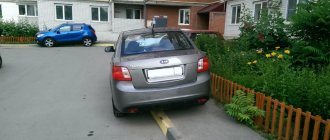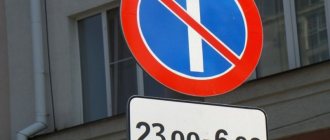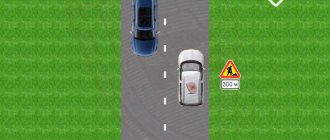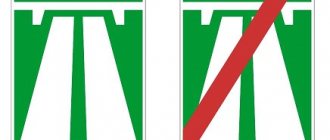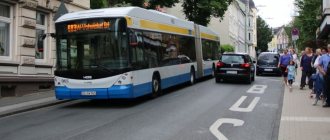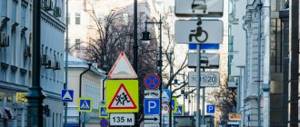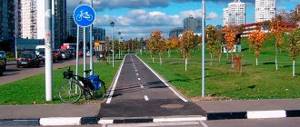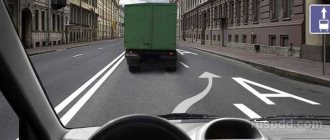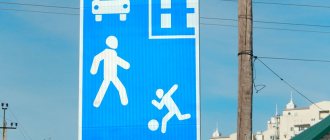Description and history
The road sign has a round shape, a blue background with a red border around the circumference and red stripes intersecting at an angle of 90 degrees - a kind of cross. Thanks to this coloring (valid since 2013), the sign is clearly visible even from afar.
In its familiar form today, this road definition appeared in 1973 after the introduction of the standard on the territory of the Soviet Union. Before this event, the specified road sign was decorated in yellow colors. The rules have been and continue to be regularly amended, but after 2013 they have not yet addressed issues related to this sign. But the size of fines (administrative liability), to the chagrin of those who are not friends with the law, has increased significantly since 2013.
Interpretation of a road sign
Sometimes motorists are annoyed when they see that stopping is prohibited. Nothing is done for nothing, especially in approved traffic rules, including those as amended since 2013. This means that on these sections of the road, a stopped vehicle can become a serious obstacle, creating emergency situations when drivers of other vehicles will be forced to break the rules when passing (for example, in areas with busy traffic, on too narrow roads, if there is a sharp turn ahead).
In places indicated by this sign, not only stopping, but also parking (or parking) of vehicles is prohibited.
In more detail, before or behind the sign it is prohibited:
- a planned stop of a vehicle for a duration longer than that required for exiting or boarding passengers, loading or unloading cargo, and, of course, parking or parking;
- any previously planned stop lasting more than 5 minutes.
In this case, a forced stop or parking is possible if the vehicle breaks down or the driver feels unwell, as well as for other similar reasons. In this case, the driver must turn on the hazard warning lights. You will also need to post an emergency stop sign on the road. If all these conditions are met, traffic police officers will not record a violation.
An exception is also provided for stopping route vehicles. These categories of road users are allowed to stop in places specially designated for them to stop, but not in front of them.
At the same time, there is no provision for imposing a fine for stopping cars driven by disabled people if the sign is supplemented with the appropriate plate (8.18) - a wheelchair is graphically displayed, crossed out with a red line.
Also, the driver should not pay attention to the installed road sign prohibiting stopping if a representative of the traffic police slows him down - this will not constitute a violation. So, he is obliged to stop at the place indicated to him by the traffic policeman or traffic police inspector.
Zone where the traffic sign is valid
The territory covered by the prohibitory action of the road sign extends to:
- intersection (this does not include a break in the dividing line, exits from courtyards in populated areas, as well as the exit of a small forest or field road);
- the place where the settlement ends (if there is no road intersection before the corresponding designation);
- a road sign has been installed that cancels all previously existing restrictions (3.31).
One more nuance: stopping (parking) is prohibited only on the side of the road where the sign is posted. For example, if on one side of the road (for example, on the right) with a one-way direction of movement, the driver paid attention to the “stopping is prohibited” sign, then this will not prevent him from stopping on its left side in an acceptable place. Parking here is not regarded as a violation and does not entail penalties.
Sign 3.27 “Stopping prohibited”: exceptions
In accordance with the disposition of the traffic rules, only public route transport that picks up and drops off passengers according to its route can be an unconditional exception to the road rules.
This basically means the coverage area of the “No Stopping” sign at public transport stops. In other cases, before stopping, you need to focus on the accompanying signs, markings, as well as additional markings on the sign itself. If tables 8.4.1–8.4.8 are placed below it , i.e. images of a passenger car, truck, car with a trailer, horse-drawn transport, motorcycle, bus, etc., then this means that the prohibition of stopping applies only to the vehicles depicted . Others are allowed to stop. Therefore, having compared your vehicle with the image on the plate under the sign and not finding any similarity, you can, sighing with relief, calmly stop to disembark passengers or park.
In addition, this road sign is often accompanied by table 8.18 . This means that the exception in the area where the sign is valid are disabled people driving vehicles with the “Disabled” identification sign. Typically, such motorized strollers and cars are driven by owners with disabilities of 1-2 groups or persons transporting them.
In the coverage area of a road sign, you can (and even must) stop at the signal of a traffic controller, since in accordance with paragraph 6.11 of the traffic rules, the driver is obliged to comply with the requirements of the traffic controller, even if they, for example, contradict the conditions of road signs and markings.
Another legal way to park and stop under a “No Stopping” sign is in case of a vehicle malfunction . But at the same time you will be obliged in accordance with clause 7.2. Traffic regulations turn on the hazard warning lights (except in cases of its absence or breakdown) and install an emergency stop sign.
Material on the topic Car evacuation
Nuances of the sign's action
The coverage area of road signs can be indicated by using signs together with a sign. So, if there is a sign 8.2.3 under the sign (an arrow that goes down), then this means that stopping before it is prohibited. If these signs are violated, a fine will be imposed on the driver who stopped immediately in front of these signs. But at the same time, stopping directly behind the sign is not prohibited and is not regarded by inspectors as a violation of the rules.
If there is a sign 8.2.2 under the sign (an arrow going up and digital symbols below it), then this sign indicates the distance within which stops cannot be made. For example, if a sign has a sign (i.e., an additional message with important information is attached underneath it), which shows an up arrow and the number 50 m, then stopping (parking) is prohibited at the specified interval, starting from the installation site.
At the same time, it is not prohibited to stop directly in front of him - accordingly, a fine will not be imposed.
If there is a sign with a double arrow pointing up and down, then this is a reminder to motorists (if the period where the restrictions apply is long) that the ban is still in effect and you cannot stop. That is, parking is prohibited in the place in front of and behind this sign.
Yellow markings along the curb or along the edge of the road (solid line) - 1.4, this determines the coverage area of the sign installed in front of it. This means that stopping and parking are allowed in front of it or after the end of the marking line. If you do not follow the indicated marks, this is automatically equated to a violation of the rules, which means a fine will follow.
The zone in which, according to the sign, stopping is prohibited, can be interrupted if there is a parking lot in this place, which is indicated by the corresponding sign (the name of the sign “Parking” was introduced in 2013).
Validity area of the traffic rules sign “No stopping”
Sign 3.27 imposes a taboo on stopping vehicles in its coverage area. The sign looks like a blue circular shield with a red border and similar colored lines that intersect to form the Latin letter “X”.
Signs can indicate the beginning of a particular settlement or its end
Sometimes the sign can be supplemented with marking 1.4, which is a yellow solid line at the edge of the road, limiting the effect of the sign to its end. In its absence, the ban applies until the first intersection or the end of a populated area, depending on which landmark you encounter on the way first.
Important! The ban applies only to that part of the road on the side of which the sign is installed.
How many minutes can you stand under the sign?
Road sign 3.27 imposes an absolute ban on stopping traffic in its coverage area. This means that you cannot stop at all under the shield, and even a fleeting pause in movement will be regarded as an illegal action.
An exception to the rules are cases when the driver made a forced brake due to a vehicle malfunction or poor health. Such factors make it possible to resort to an emergency stop even under a prohibitory sign.
Additional signs with arrows
A shield that prohibits stopping movement can be supplemented with additional signs that affect its coverage area. Thus, an additional sign with an image of an up arrow should be regarded as a signal that the restriction has come into force, and it will be impossible to stop after the sign.
If there are also numbers next to the arrow, then they indicate the range of the indicator in meters (8.2.1 and 8.2.2). A driver who sees a sign with two arrows facing in opposite directions (sign 8.2.4) can be sure that he continues to be in the prohibited zone.
A sign with a down arrow (8.2.3) indicates that the limiter has expired and you can stop. Signs with arrows pointing to the sides help the driver determine the prohibited area. These include signs 8.3.1-8.3.3.
Validity of the sign on even and odd days
Often on the roads you can see a “no parking” sign, which is supplemented by one or two vertical lines. These stripes indicate that the sign is valid for a limited time. Thus, a sign with one line prohibits parking on odd days, and a sign with two lines prohibits parking on even days.
Designation of prohibitory signs that operate only on even or odd days
Such temporary restrictions apply only to sign 3.28, which prohibits long-term parking of a car, and not a short stop. And the sign that imposes a taboo even on stopping traffic for a minute is valid every day, regardless of the date, which is important for every driver to take into account.
